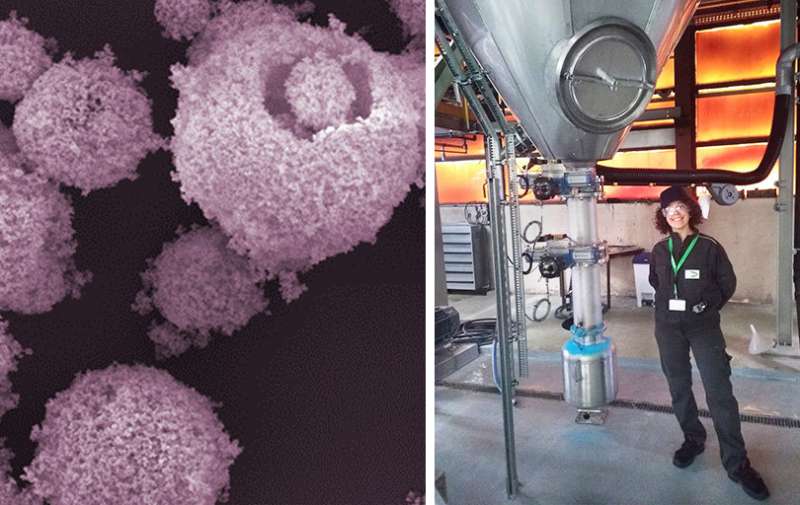A step toward metal organic framework synthesis

Dr. Inhar Imaz and ICREA Prof. Daniel Maspoch are the brains behind a new method for metal organic framework synthesis. Their spray drying technique is expected to significantly advance the commercialisation of MOFs.
A group of EU project partners (ProDIA) has successfully developed synthesis processes enabling the manufacture of metal organic framework (MOFs) materials at an industrial scale. These innovative methods have significantly reduced production costs, permitting MOFs to be priced competitively against many current market-leading materials. With the ability to offer these advanced porous materials at an economically viable price, the projected benefits from their superior performance can now be realised.
Metal organic frameworks (MOFs) are among the most exciting materials to have emerged in the last two decades. They are powdered solids composed of metals or metal clusters linked by organic ligands into extended networks, which often have very high porosity in the nanopore range (1 nanometre = 10-9 m). It is these small pores or cavities that make these MOF materials ideally suited for the storage of gases such as CH4, H2O, CO2, NH3 and NO, among others. Coupled with their chemical flexibility, MOFs have great potential in a diverse range of sectors covering energy, environmental and biological applications.
The consortium has successfully achieved significant advances in two areas critical to MOF industrialisation/manufacture and shaping/formulation. Several manufacturing processes were explored, developed and validated to enable the multi-kilo scale production of a structurally and chemically diverse range of MOF materials. Suitably shaped bodies and formulations comprising the manufactured MOF powders were fabricated, characterised and tested for use in the key application areas of gas storage for clean mobile energy, waste heat-based cooling solutions for data centres, air purification, and prevention of medical device-acquired infections. Data collected in side-by-side testing with industry benchmarks proves the superior performance achievable from the manufactured materials, confirming their immense future potential.
A group of researchers lead by Dr. Inhar Imaz and ICREA Prof. Daniel Maspoch at the Catalan Institute of Nanoscience and Nanotechnology (ICN2) developed one of the new methods for MOF synthesis: spray-drying. The ICN2's spray-drying method was first published in Nature Chemistry in 2013. It was patented and licensed to fellow ProDIA partner MOFApps by 2015. Now, it has been scaled up from gram- to kilo-scale production in collaboration with the research group led by Prof. David Farrusseng (IRCELYON, CNRS), MOFApps and Axel'One.
The key to this swift journey from lab to industry is that the method has been adapted from a common industrial process that requires no specialised equipment. It also uses water as the reaction medium, making it a low-cost, environmentally friendly route to the continuous production of a range of porous MOFs. Unique in Europe, the proof-of-concept installation located at Axel'One stands 10.5 metres tall and yields several tens of kilos of the copper-based MOF, HKUST-1, in just a few hours. This is an important step toward industrial-scale production (~300kg/day) of MOFs via spray drying, which would give these materials the competitive price point they need for mass uptake.
More information: Arnau Carné-Sánchez et al. A spray-drying strategy for synthesis of nanoscale metal–organic frameworks and their assembly into hollow superstructures, Nature Chemistry (2013). DOI: 10.1038/nchem.1569
Journal information: Nature Chemistry





















